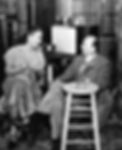18. MILDRED PIERCE, 1945
- Jay Jacobson
- Aug 18, 2020
- 11 min read
Updated: Aug 28, 2021
A Hollywood legend stars in a scintillating film noir melodrama

This week we are looking at the classic “Mildred Pierce”, which has been classified as film noir, drama, and a crime story. It is all of those and more! This emotionally heightened, cliff-hanging melodrama, expertly done in a noir style with just about all the noir elements, is very well crafted, exquisitely shot, and exciting to watch. I talk more descriptively about film noir in the "Double Indemnity" post.“Mildred Pierce” also contains one of the most intriguing and complex mother/daughter relationships onscreen. And if you want a prime example of the technical artistry of classic films, just notice the stunning shadows throughout the film. If all that wasn’t enough to make a compelling film, it stars Joan Crawford, one of the legends of Hollywood in what is regarded as her best performance. With all its grandeur “Mildred Pierce” is ultimately a film about the price of money and love, when either are pursued at all costs. This film was nominated for six Academy Awards including “Best Picture”, winning one for its star’s brilliant performance.


“Mildred Pierce” was skillfully directed by Michael Curtiz, a prolific director whose credits include some of the most famous Hollywood classics of all time. He was an expert at directing successful films in just about every genre, including drama, adventure, musicals, epics, westerns, romance, melodrama and noir. Born in Hungary where he began as an actor, he soon became a top director. Warner Brothers offered him a directing contract and he came to Hollywood in 1926 where he made films for the rest of his life. In 1935 Curtiz took a risk on two little known actors, Errol Flynn and Olivia De Havilland, casting them as leads in his costume adventure, “Captain Blood”. That film turned out to be a big success and both actors became two of the biggest stars in Hollywood. I talk more about Olivia in my “The Heiress” post. Information about Errol will be coming up in a future blog.

Michael Curtiz worked with many top stars, often extracting their best performances, including Bette Davis, Humphrey Bogart, Doris Day, Paul Muni, James Cagney, Joan Crawford, and more. He is also credited with discovering the marvelous actor John Garfield, casting him in his first film, “Four Daughters”. Curtiz had a reputation for perfection at any cost, and was known to be a bully with a nasty temper. Bette Davis, who worked with him on seven films, respected his expertise but called him the “cruelest man I have ever known”. Curtiz would do anything to get the shot, even being reckless on occasion. While shooting his semi-silent 1928 classic “Noah's Ark”, it was rumored that several extras died while filming the famous flood scene. In another incident, while filming an action sequence in the classic 1936 film “The Charge of the Light Brigade”, over two dozen horses had to be put down from injuries they incurred from using trip wires to get them to fall. That episode was one of a couple key to having the American Humane Association oversee the treatment of animals in films (thus the statement seen at the end of a film, “No Animals Were Harmed in the Making of This Film”). Despite his temperament and safety shortsightedness, Curtiz managed to make fantastic movies throughout his career, and was Warner Brothers Studio's most important director. Many of his films will be presented on this blog. He directed well over 150 films in his lifetime. Just some of his classics include “Casablanca”, "Angels with Dirty Faces", "Yankee Doodle Dandy", "White Christmas", "Noah's Ark", "20,000 Years in Sing Sing", "The Private Lives of Elizabeth and Essex", The Adventures of Robin Hood", "The Sea Hawk”, and of course, "Mildred Pierce”. Michael Curtiz died in 1962 at the age of 75.


Joan Crawford, an icon, trendsetter, and queen of Hollywood, stars as “Mildred Pierce Beragon”. She was a star probably longer than anyone else, and is one of Hollywood's most fascinating personalities. Filled with relentless drive, beauty, brains, and ambition, she worked her way from being a chorus girl to a world-renowned star. She was expert at creating, changing, and maintaining her celebrity. Known as a consummate professional, she learned the business inside and out, knowing her best lighting, her best angles, the entire script of each of her films (including the lines of all her costars), as well as the technical aspects of filmmaking. She learned being kind to the people behind the camera paid off and was loved by most film crews. Joan knew the value of publicity and was always shrewdly looking for ways to get herself in the spotlight. A related example I love is how she became George Hurrell’s most photographed subject. Hurrell was the preeminent Hollywood glamour photographer. The story, found in Mark A. Vieira’s book, “George Hurrell’s Hollywood”., quotes Joan Rose, a photo archivist who knew Hurrell. Rose said, “George had finished shooting somebody who didn’t like having his picture taken and was out of there by three. And Crawford would know that George had a couple hours left. Lo and behold, there she was, waiting to have her picture taken. ‘Don’t you like this dress?’ Or ‘Isn’t this the most adorable hat?’ (she’d been down in wardrobe, carrying on). And she came to him because she had this instinct that these photographs were important to her career".

Joan also knew the importance of the public and religiously signed autographs, answered fan mail, and often made public comments that the fans made her who she was. Joan Crawford, originally named Lucille Fay LeSueur, was born into poverty, with a father she didn’t know and a mother she didn’t like. Determined to be a movie star she began as a dancer in troupes, then a chorus girl on Broadway, finally moving to Los Angeles to fulfill her dream. She got a contract as a dancer with MGM in 1925 and started working her way through the business appearing everywhere she could for publicity. MGM changed her name to Joan Crawford in a public contest, and with her new name she was on her way, starting to work opposite some of the biggest silent stars, including John Gilbert, Lon Chaney, Ramón Novarro, and William Haines. Joan had a reputation offscreen for drinking, dancing and sleeping around (including with her directors and costars throughout her career) and in 1928 MGM found a vehicle titled “Our Dancing Daughters” in which she played a role close to her reputation. It became her big break and made her a star. Shortly after, with sound films she soon found herself one of Hollywood’s top stars. I especially love her early performances as she had an energetic innocence so infectious you can’t take your eyes off her. She was paired with Clark Gable early in her career (they ended up making eight films together), and they had an off and on again affair. In the 1939 classic comedy “The Women”, Joan played the villainess in an all-star female only cast, and was so good you love to hate her. She was now considered a serious actress. In the late 1930s she was losing popularity and was labeled “box office poison”. She left MGM, went to Warner Brothers and “Mildred Pierce” was her grand comeback. For it she won a “Best Actress” Academy Award and was once again a top star. In this role she showed a new depth and restraint which set the trend for the rest of her career. She would receive two more "Best Actress" Oscar nominations - one for the 1947 film "Possessed", and one for 1952's "Sudden Fear”.

Joan continually changed her looks over the years, implementing her trademark shoulder pads, ever growing eyebrows, and outlined lips. Towards the end of her career she began to look a bit scary (not intentionally). Starting in the 1960s she appeared chiefly in low budget “B” (or even "C" or "D") horror films. A high point was the classic 1962 horror film “Whatever Happened to Baby Jane?” in which she co-starred with real life rival Bette Davis. More on their rivalry when I present that film in an upcoming entry. Joan also worked on television at this point, famously appearing in a classic episode of “Night Gallery” directed by newcomer Steven Spielberg. She appeared in just over 100 films and TV shows in her career, and some of her other not yet mentioned classics include “Grand Hotel”, “Rain", “Humoresque", "Autumn Leaves", Harriet Craig", and "Johnny Guitar”. She married three actors: Douglas Fairbanks Jr., Franchot Tone, Phillip Terry. Her fourth and final marriage was to Pepsi Cola executive Alfred Steele, and Joan became the face of Pepsi (again, great publicity). She could never have children so she adopted five (four while she was single). Joan Crawford died in 1977 at the age of 73. In her will she disinherited two of her adopted children including her first, Christina. One year after Joan’s death, Christina published a scandalous, best selling book about her mother titled, “Mommie Dearest”. In it she explicitly told of abuse she suffered at the hands of her mother, as well as Joan’s alcohol addiction, cleanliness compulsion and other shockers. Some people refused to believe the book although there have been many confirmations of its validity. A film version of the book was made in 1981 starring Faye Dunaway as Joan, which made the phrase “No wire hangers ever” part of pop culture. That film has since become a camp classic. Who would have known that a 312 page paperback would forever change the image Joan Crawford dedicated her whole life to meticulously creating? She did leave behind a tremendous legacy of very engaging films and fine performances. You will see more of her films in upcoming posts.


Jack Carson, who plays “Wally Fay”, was an accomplished character actor who appeared in over 100 films and TV shows, predominantly comedies, sometimes musicals, and occasionally dramas. A big and tall guy, he was usually the second lead, often playing friendly, sometimes shady characters with a chip on their shoulder and a sense of humor. I always found him very likable and was surprised to find out my father wasn’t a fan. In “Mildred Pierce” Jack brings an outstanding balance of humor and brashness. He worked in films and television from the late 1930s until the early 1960s, appearing in several classics including “A Star is Born”, “Cat on a Hot Tin Roof”, “Arsenic and Old Lace”, "Mr. & Mrs. Smith", "Stage Door”, "Gentleman Jim", "Hollywood Canteen", "It's a Great Feeling", and of course, "Mildred Pierce”. Jack Carson died in 1963 at the age of 52.


Eve Arden is so entertaining as “Ida Corwin” in “Mildred Pierce”, for it she received her one and only "Best Actress in a Supporting Role” Academy Award nomination. An actress and comedienne you can’t help but love, she had spot-on comic timing and a wonderful sense of humor. No one is better at delivering a deadpan quip than Eve Arden, and she does a first rate job of it here, offering the humor in this film. Always unique, Eve Arden began her career the opposite of most actors - starting in a couple of films, then doing Broadway (including appearing in “The Ziegfeld Follies”). She returned to films in 1937 while continuing on Broadway. Eve was best known as the wisecracking school teacher “Constance ‘Connie' Brooks”, in “Our Miss Brooks”, which began as a radio show, then a very successful 1950s TV show for which she won an Emmy), and a film in 1956. She appeared in just about 100 films and TV shows, including the classics "Stage Door", "Ziegfeld Girl", "Cover Girl", "Anatomy of a Murder", "Grease", and possibly my favorite episode of "I Love Lucy” (“Hollywood at Last”) where she has a very brief but hysterical cameo playing herself. Eve Arden died in 1990 at the age of 82.


Ann Blyth, who is so believable as “Veda Pierce Forrester”, is one of the last remaining Golden Age Hollywood stars alive today (as of the writing of this post). She received a "Best Actress in a Supporting Role” Academy Award nomination for “Mildred Pierce” (her only nomination), and it would become her most remembered role. Ann began as a child in radio and theater, then began appearing in films in 1944. “Mildred Pierce” was her fifth film. She appeared mostly in musicals and dramas, including "Kismet", "Rose Marie", "The Great Caruso", "The Student Prince", "The Buster Keaton Story", and her last film, playing the title role opposite Paul Newman in 1957’s "The Helen Morgan Story” (also directed by Curtiz). Ann worked in television from 1959 until 1985. On August 16 Ann Blyth will turn 92.


Also of note in “Mildred Pierce” is actress Butterfly McQueen who plays “Lottie”. Famous for her unusual high voice, she was very skillful at playing comedic scatterbrained characters. She began in theater, and then Broadway before appearing in films where she became part of Hollywood history in 1939 with her role as “Prissy” in the classic, “Gone with the Wind” (a landmark film coming up on this blog). Butterfly only made about a dozen films, about half of which are top classics including “Gone with the Wind”, “The Women”, "Cabin in the Sky", "Since You Went Away", "Duel in the Sun", and "Mildred Pierce”. Due to the ethnic stereotyping at the time, she often played the part of a maid or service worker of some type. Tired of that, she stopped making feature films after 1948 (except for one in the 1970s and one in the 1980s), concentrating on radio and television from 1950 on. In addition to her voice, she had a very unique way about her and is someone your eyes naturally gravitate towards. Butterfly McQueen died due to complications from a house fie in 1995 at the age of 84.


The film score for “Mildred Pierce” was by legendary film composer Max Steiner, who I briefly spoke about in the “King Kong” post. As with just about all his work, this score is a perfect partner for heightening the film’s mood, tone and drama. Born in Austria, he was a composer and orchestra leader before coming to Hollywood in the late 1920s. During the early talkies he was one of the pioneers of composing music for films. This earned him the title of the “Father of Film Music”. Known largely for romantic and dramatic scores, Steiner helped create emotion and mood in so many classic films including “Casablanca”, “Jezebel”, "King Kong”, “The Letter”, "Since You Went Away”, “Now Voyager”, ”The Caine Mutiny", "Sergeant York", 'Dark Victory", "The Gay Divorcee", "Johnny Belinda”, "The Informer", "Adventures of Don Juan”, "Jim Thorpe - All-American", "White Heat", "The Treasure of the Sierra Madre", and most iconically "Gone with the Wind”. The list can go on and on as he composed well over 200 film scores. He was nominated for an Academy Award every year from 1935 through 1956 (with the exception of three years), garnering a total of 24 nominations, and winning three Oscars. His contribution to classic films is indelible. Max Steiner died in 1971 at the age of 83.
“Mildred Pierce” was remade as a mini-series for HBO in 2011, starring Kate Winslet, Guy Pearce, Evan Rachel Wood, and Mare Winningham. While the 5-part series was good, it doesn’t have any of the magic this film holds.

Get ready to enjoy an exciting film with an impressive ensemble, filled with technical beauty, and containing a stand out performance by a Hollywood icon. Enjoy the intoxicating “Mildred Pierce”!
YOU CAN STREAM OR BUY THE FILM HERE:
OTHER PLACES TO BUY THE FILM:
TO READ AFTER VIEWING (contains spoilers):


A fun note: Joan Crawford did a lot of face slapping in her films (mainly in the 1940s and 50s), not just in “Mildred Pierce”. She slapped so many faces that it almost became a trademark of hers. In the 1949 musical comedy "It's a Great Feeling", starring Doris Day, Jack Carson and Dennis Morgan, Joan (along with many other stars) had a very brief cameo playing herself. In her scene (looking gorgeous in full color) she is, of all things, sitting in a dress shop knitting, while wearing a fur coat. She overhears Jack and Dennis talk about putting on and taking off Doris’ dress, which causes her, out of the blue, to deliver an edited version of the dialogue from “Mildred Pierce”, motioning to Doris Day not to interrupt her monologue. The dialogue is taken from the famous scene before and after getting slapped in the face by Veda on the stairs. Joan ends her monologue in the scene slapping the faces of both Dennis Morgan and Jack Carson. After which Jack asks her, “What was that for?”. Joan replies “Oh, I do that in all my pictures”. Such a fun way to poke fun at oneself. The moment is priceless!


Another fun note: I was fortunate enough to attend a viewing of The Debbie Reynolds Auction in 2011. I was in awe seeing so many famous costumes from so many classic films. How surreal to see them in person, and many in color for the first time. One of the items up for auction was the iconic waitress uniform worn by Joan in "Mildred Pierce". Because this film is so beloved and such a classic, the uniform sold for $22,500!
I also find it interesting that in "Mildred Pierce" Joan Crawford gives what is generally said to be the best performance of her career. In it she plays a mother who sacrifices everything for the love of her daughter, while if you've read "Mommie Dearest" she was the exact opposite.




